Moula Ali hill
Moula Ali hill also known as Maula Ali, had the ancient name dome-shaped hill located in Moula Ali, Hyderabad, India. It is well known for the Moula Ali dargah and shia masjid, which are both on top of the hill. The area is maximally inhabited by Shia Muslims.
| Moula Ali hill. | |
|---|---|
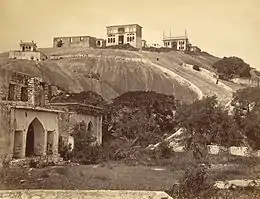 Moula Ali hill in 1875 | |
| Highest point | |
| Elevation | 614.7 m (2,017 ft) |
| Coordinates | 17°15′57″N 78°35′48″E |
| Geography | |
 Moula Ali hill. Moula Ali hill is located in northeast Hyderabad | |
| Location | Moula Ali, Hyderabad, India |
| Climbing | |
| First ascent | Maula Ali |
| Easiest route | 484 steps |
Overview
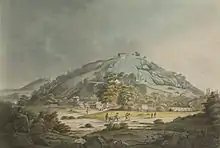

The Moula Ali hill is approximately 614 metres (2,014 ft) tall.[1] It has 484 steps from dargah to bottom of the hill and has about 600 tombs around it.[2]
There is another hillock near the Moula Ali hill, called "Qadam -e- Rasul", on which the sacred relics of the prophet were deposited by Mohammad Shakrullah Rahan, a servant of Asaf Jahi.[1]
History
The area near the hill has been inhabited by humans since Neolithic times. Excavations have found pottery, iron tools and fragments of human skeleton near the site.[2]
In 1578, a eunuch of the Qutub Shahi court named Yakut was ill. He dreamt that a man in green dress told him to visit Moula Ali hill because Ali was waiting for him on top of the hill. In his dream Yakut went to the hill with the man and saw Ali sitting on top of the hill resting his hand on a stone. The next morning, Yaqut's illness was cured and a stone was found on the hill, which is said to have had the hand marks of Ali on it. After hearing about this incident, the Sultan visited the hill and ordered a dargah to be built on top of the hill. The stone that was found is kept in the shrine on top of the hill.[1][3][4][5]

The hill was named 'Maula Ali', which means 'Master Ali', after the incident. The stone became popular for sufis, ascetics and mystics because of the belief that the stone has healing powers.[4]
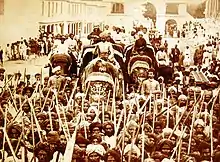
Qutub shahi sultans began an annual pilgrimage on 17th Rijab to the hill from Golconda, but after sunni Muslims conquered Hyderabad in 1687, the festival temporarily stopped. In the Nizams rule, this festival became one of the two important national festivals.[4]
Moula Ali dargah
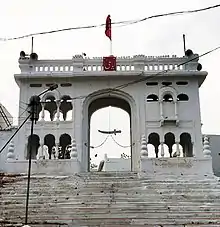
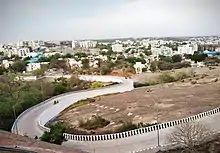

The Moula Ali dargah is located on top of the hill. It was built by Sultan Ibrahim Qutub Shah[1] and it is the only dargah dedicated to maula Ali, son-in-law of Prophet Muhammad.[6][7] Its interior is decorated with thousands of mirrors[3] and it is one of the 11 heritage sites in Hyderabad, identified by the "Heritage conservation committee" of HUDA.[8] It is well known fact that Maula Ali Hill has engraving of the hand of Ali Ibn Talib, the fourth caliphate of Islam. It is revered by millions of people around the year.
References
- Syed Ali Asgar Bilgrami (1927). Landmarks of the Deccan: A Comprehensive Guide to the Archaeological Remains. ISBN 9788120605435.
- Hyderabad (India). Dept. of Information and Public Relations (1953). History and legend in Hyderabad.
- Sarina Singh; Lindsay Brown; Paul Harding; Trent Holden; Amy Karafin; Kate Morgan; John Noble (1 September 2013). Lonely Planet South India & Kerala. ISBN 9781743217948.
- William Dalrymple (27 April 2004). White Mughals: Love and Betrayal in Eighteenth-Century India. ISBN 9781101098127.
- Syeda Imam (14 May 2008). The Untold Charminar. ISBN 9788184759716.
- Harriet Ronken Lynton (1987). Days Of The Beloved. ISBN 9780863112690.
- Director of Print. and Stationery at the Government Secretariat Press; [copies can be from: Government Publication Bureau, Andhra Pradesh], 2000 (2000). Andhra Pradesh District Gazetteers: Ranga Reddy.
{{cite book}}: CS1 maint: multiple names: authors list (link) - Madhu Vottery (11 December 2012). A Guide to the Heritage of Hyderabad. ISBN 9788129125842.